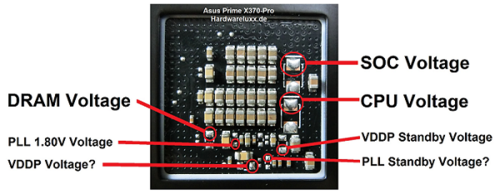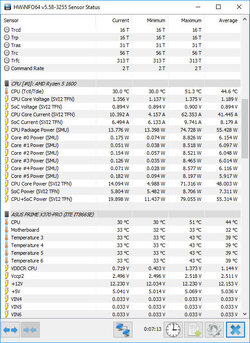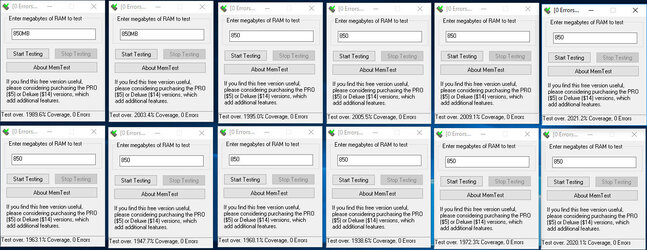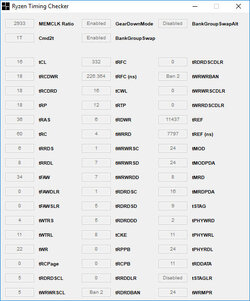- Joined
- Aug 11, 2015
- Thread Starter
- #281
Any luck with increasing your memory clocks or better stability?
Welcome to Overclockers Forums! Join us to reply in threads, receive reduced ads, and to customize your site experience!
Any luck with increasing your memory clocks or better stability?

Wondered if you were going to make me search for that info. The search function on OC.net are not the best.
Lermite has done good oscilloscope probing.
Prime X370 socket back
View attachment 193734
Disregard bottom image of C6H socket back.
Sorry, I figured if anyone was going to know, it would be in this thread. I just want to make sure I'm not throwing too much juice at my CPU is all. Then i'll know how accurate the software reading is, and how much room I have to play with. I'm gonna try for 4.0Ghz, but I'm perfectly happy with 3.9Ghz. Just want to see if this chip will do 4.0.
Unfortunately, this thread mostly petered out till you showed up. The early posters were mainly just interested in benching the Ryzen for max clocks and then sold off the systems they built and moved on to the next big thing platform. Not many are actually interested in using Ryzen as their day to day computing platform. Most of the technical knowledge is over in the Overclock.net Ryzen threads. They are 100X more active than here.
I have an interest in many areas, and distributed computing is one of them too. It still isn't cool enough for me to fire up my farm, but why not have some fun on the hardware until then?
I've been finding set and forget cruncher stability to be more challenging over time, with some light OC systems I thought were stable no longer being so (may crash one every several days/weeks). Not had time to revisit though and just took the lazy option of removing OC. They were never heavily OC anyway as power optimisation becomes more important than all out performance.

I see. Well, I've found out quite a bit thanks to you and Johan. I'll have to check out those forums as well. I do use this as my everyday machine. I don't know why people wouldn't. I guess because overclocking isn't as nice of a thing with Ryzen. That's not my main purpose. I use this as a gaming, streaming, and video rendering machine. It's perfect for what I do. Sure, it's not a higher overclocker as an Intel, but this is a new platform, and I look forward to what AMD does with Ryzen 2. I've never been much of a fan of Intel, from their dirty business practices that almost wiped out AMD, to their way of holding CPU progress for years until AMD finally came out with Ryzen.
I've never owned an Intel system, and I never will. My personal preference. I know this isn't the best CPU on the market, but I can't afford the best anyways. This board + CPU is cheaper than just an i7 is by itself, and it's performance may not match in games, but it only needs to feed my GPU good enough to do 60 FPS, and I'm good with that.
I do like to tinker and figure things out, and Ryzen is a challenge to dial in. This is good. I'm learning a lot about this board and Ryzen, and I want to squeeze every ounce of performance I can out of my hardware. That's what I did with my Phenom II for years, and I plan on sticking with this platform for many years to come. I skipped the FX series, and waited. I'm not really a fanboy, but I can't support Intel.
Going back to what you said about people moving on, I don't get it, the platform is so new and more performance is being eeked out with better BIOS updates and memory support. Guess we'll be the benefactors, as I can't just sell off this stuff and jump on the new shiny every time something is released.
basically comes down to problems with Windows 10 Home and it wanting to reboot the machine on its own terms and not my own.
Pretty much the same viewpoint as I. I was on the bleeding edge of computer technology with Intel up through 486. But I finally got disgusted with the $1000 processors and gave the Nexgen 586 a try because it had 3/4 the performance at 1/3 the cost. That led me onto AMD and I have never looked back at Intel.
The problem with this website is its genesis seems to have been solely an overclocking and benching site. Once the OC'ers found out that Ryzen has a ceiling of 4 Ghz, then they lost interest because Intel was giving them 5 Ghz systems and something to brag about and post scores to the benching sites. Most don't even consider the multi-thread performance a plus for Ryzen, they are just interested in single thread performance and high IPC for gaming.
Since AMD also upped IPC close to Intel, lazy programmers may not see any need to change to a more multi-threaded software model.
Wondered if you were going to make me search for that info. The search function on OC.net are not the best.
Lermite has done good oscilloscope probing.
Prime X370 socket back
View attachment 193734

I suppose they wouldn't have to, but at some point consumers are going to demand it. With the HEDT segment getting their hands on 16 and 18 core CPU's it's gonna have to happen at some point. The mainstream segment is about to get 6 cores from Intel, and with Ryzen already offering 8 core CPUs, I don't see how long the software people could flounder about.
I worked on a program where they floundered about for 20 years. Consumers don't need all those cores/threads and HEDT is a niche market. Ever since Bulldozer, the AMD'ers dream has been that multi-threading was going to suddenly be adopted immediately everywhere. It will happen, just not anytime soon.
Any luck with increasing your memory clocks or better stability?

